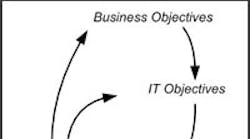Rethinking ROI: Not the Best Measure of IT of Project Value
In the world of IT, ROI is king. But should it be? How many approved IT projects have you seen with projected returns that -- in spite of the vetted calculations -- you just didn't believe? And how many projects, rejected because ROI couldn't be calculated or proved, would have turned your company into a well-oiled machine? ROI can be a great tool, but it's not the only mechanism for judging value. You may be using the wrong tool -- like using a chisel instead of a screwdriver.
Let's look at some situations that arise when managing information technology and see how well ROI works in each instance.
The Broad View of IT Value
"Information Technology" -- both the technology itself and the department or team organized to apply it -- is a means to achieve business objectives. Its value is derived from how well it achieves this objective. So, how is value achieved?
- The company sets its business objectives (e.g., establish manufacturing sources in two new continents).
- IT sets its own objectives consistent with its mission and with the business objectives (e.g., enable integration with external manufacturer's applications).
- IT designs its projects and services with the intent of achieving its objectives (e.g., build secure remote manufacturer communications, develop integration toolbox, extend reporting dashboard for extended manufacturing systems).
- The outcome is changed operations and the concomitant benefits.
- The changed operations drive achievement of the business objectives and the IT objectives.
So what's the value of IT? It's in the achievement of its internal customer benefit objectives (ability to exchange designs with remote manufacturing systems, in this example), and it's in the indirect achievement of the business objectives (establishment of new manufacturing sources). If these objectives have been designed correctly, they're measured over the long term, and over many projects. The value of IT is not in the ROI calculation of any one project (extended dashboard for reporting, for example).
ROI may be illustrative for a single project, but it's not a measure of IT value.
Making Project Choices
There are always more projects than there is budget flexibility, so how does an organization choose? The snap answer is "pick the projects with the highest ROI for the money" -- but not so fast. Would you choose a project, all other things being equal, if another project brought some capability on-line more quickly (time to business impact)? Probably not.
On the other hand, would you pick a project that yielded no new revenue, but prevented erosion of revenue from a competitor? Probably, because the business impact is potentially significant.
Good IT governance suggests that there be a sensible, understood, and predictable scheme for choosing projects. This requires a scoring scheme agreed to by all who have a say in IT's work. The scheme can have any number of factors -- ROI/impact, conformance with objectives, number of objectives served, time to impact, etc. Pick your factors and the weighting of each. Certainly ROI fits into the scoring scheme, but it's not the only factor.
Innovation and ROI
One way to improve IT's value to the business is to assure that it's an agent for positive change. One way to judge IT's support of change is to classify projects by whether they're about running the business, transforming the business, or growing the business; a high proportion in the first category isn't a good sign.
Interestingly, the ROI calculations for projects in these categories are different. ROI calculations for the least desirable category of projects are the easiest to make and may be the most credible, unfortunately!
Running the business includes all IT activities that support day-to-day operations of the business. IT Projects in this group are often motivated by cost savings.
Calculations for projects of this kind are usually straightforward -- you can compare the projected cost reduction with the amortized investment. Examples include hosting or server consolidation or outsourcing support. The "optimism" of each assumption, in the author's experience, is easily judged, largely because the facts are available (assuming vendor proposals are credible). But, as car manufacturers caution about EPA estimates, "Your mileage may vary."
Growing the business includes work focuses on increasing revenue or sourcing capability, fueling organic growth, increasing demand, or supporting a new line of business.
Here, you can compare the projected growth with the amortized investment. Examples include building an e-commerce channel to supplement the sales force, or offering a new low-cost self-service plan. But how do you project growth? In the author's experience, some of these projections are wildly optimistic. To be credible, these ROI projections must be vetted by an experienced and knowledgeable group and may require some market research or research into past industry experience with similar work. There may be fewer facts on which to base the proposed benefits.
Transforming the business includes work that transforms the way the company does business through faster or less work-intensive business processes or that supports new business models.
Projects in this group are motivated in the belief that IT can be an innovative and disruptive force, driving business to change for the better. Often, these projects drive business process changes. Frankly, who knows the outcome with certainty? CRM is a perfect example. How can you calculate the benefits of knowing your customers better or of the personalized touch you can now offer them? How can you calculate the benefits of management's increased ability to understand in near real time where that new product is failing and succeeding?
Because transformations almost always have unintended consequences -- good and bad -- it's impossible to predict all the outcomes.
In summary, ROI projections can be highly credible for run the business IT projects. They will be will be less so for grow the business projects. ROI calculations can be illustrative examples for various scenarios in transformation projects, but they're not definitive. So, use them where they're real predictors, but take them with a grain of salt where they're suggestive.
It's That Vision Thing
Vision is the ability to see possibilities -- possibilities far in the future, or possibilities arising from proper alignment of strategy, resources, and external forces. Vision requires a holistic view, taking into consideration all the "moving parts," all the effects the parts and forces have on each other, and all the delayed and indirect effects involved. Vision requires intuition, and visionaries often go on faith-faith that even though they can't necessarily quantify the enabling mechanics and the outcomes, the result will be great.
Calculating the expected return on an investment requires a different kind of thinking. It requires choosing and quantifying a manageable number of variables and assumptions. It requires quantifying the relationships and validating the computations based on experience and research. But this becomes increasingly difficult and expensive as the assumptions, variables, and relationships grow in number, by virtue of the research and experience needed to validate them.
Broad visions have too many unprovable calculations to be judged by ROI analysis. So take bold steps based on broad visions. Building a bulletproof case may kill your vision or your market leadership.
There are cases where ROI can be a valid and valuable tool for assessing the value of an IT project. But it's not the only measure by which to score the value of a project, and it's certainly not a measure of IT's value to the organization. Beware the use of ROI as the primary criterion for IT work.
Stephen Lipka PhD, CMC is a Principal of Avatar Strategic Partners, where he guides clients to higher profits through better use of information technology. He can be reached at [email protected]
Interested in information related to this topic? Subscribe to our Information Technology eNewsletter.



